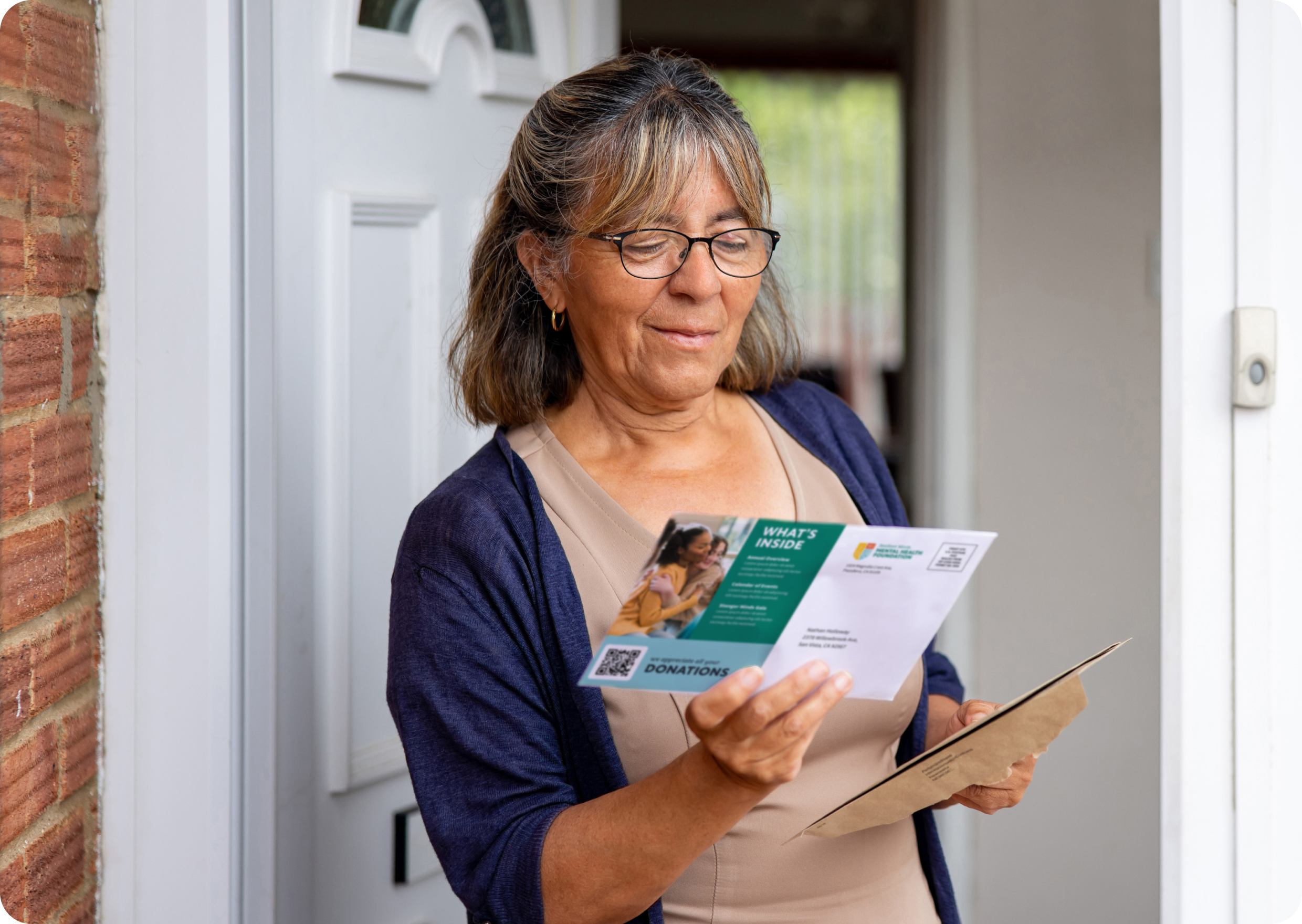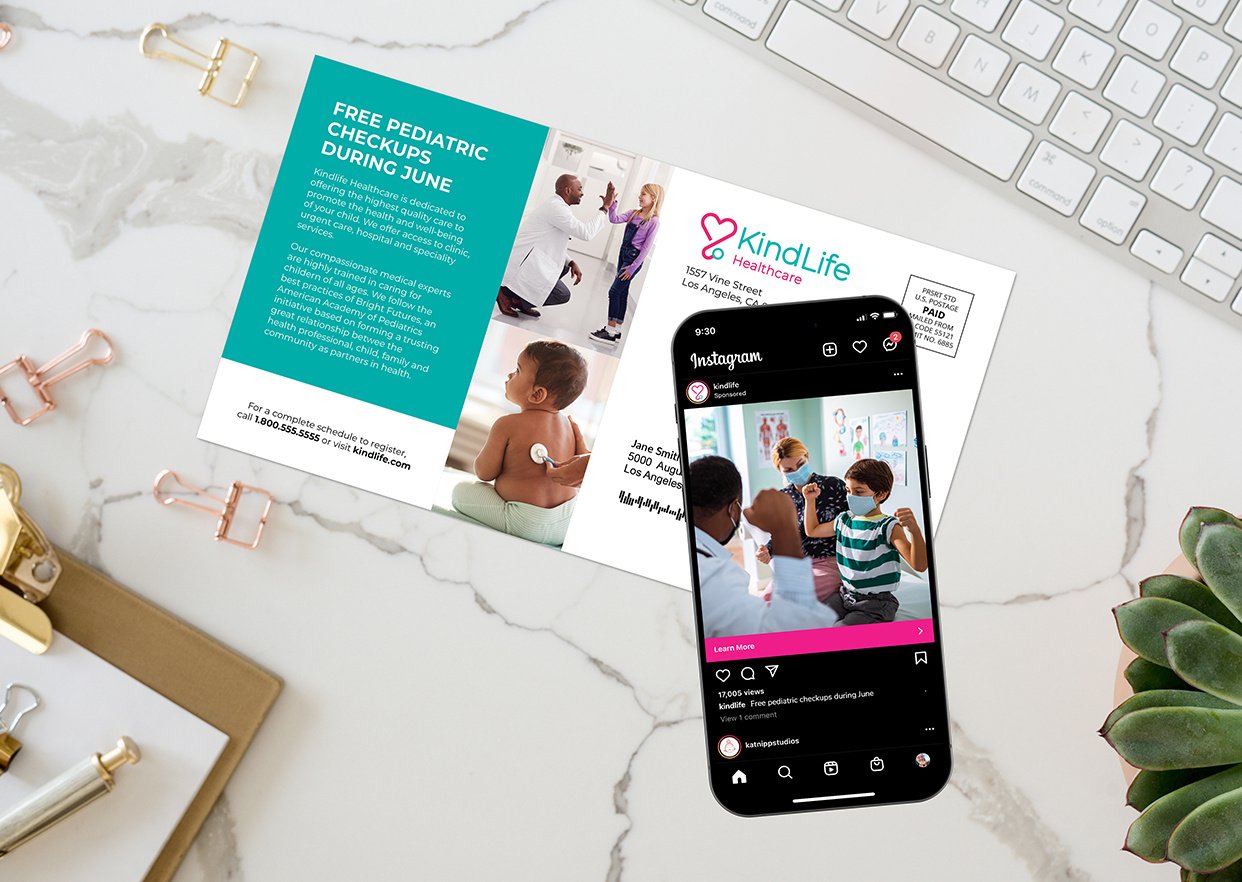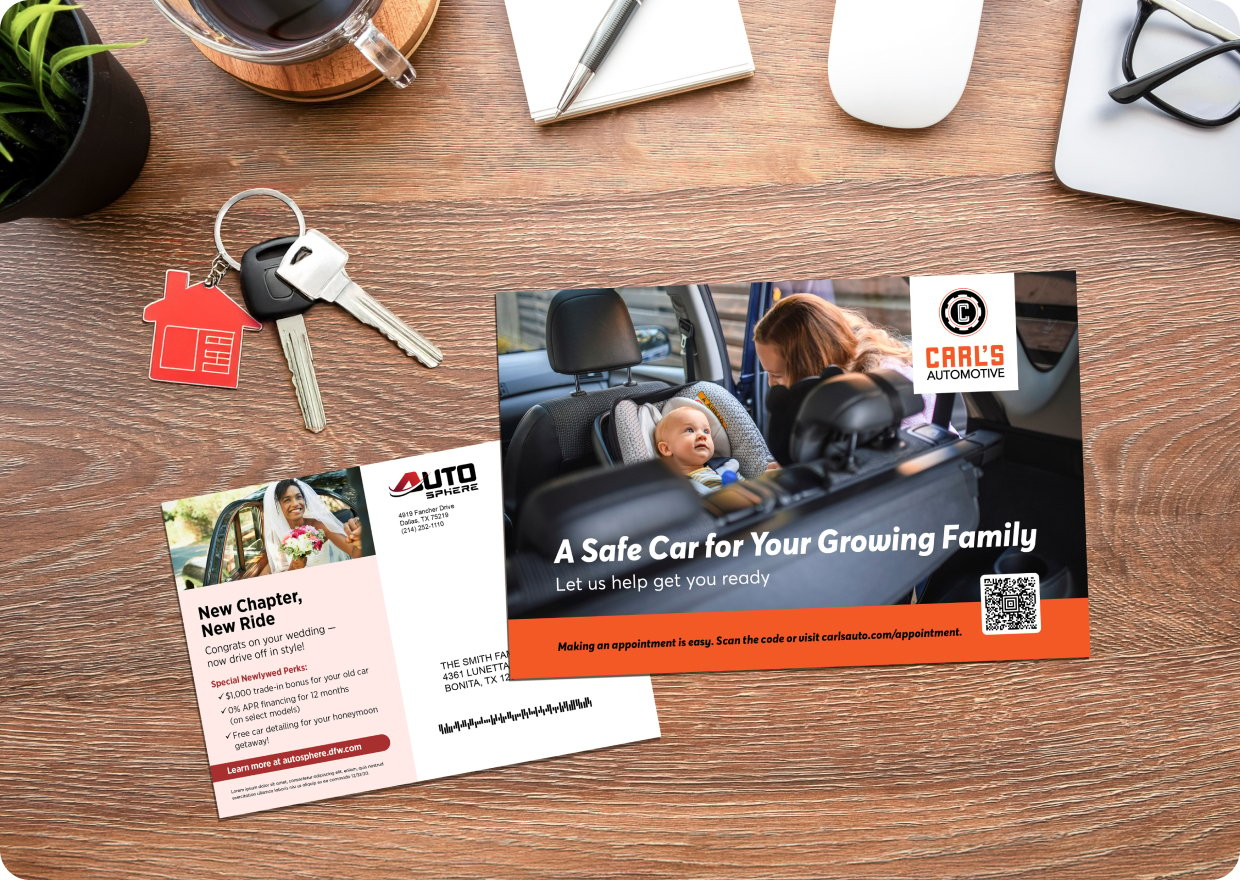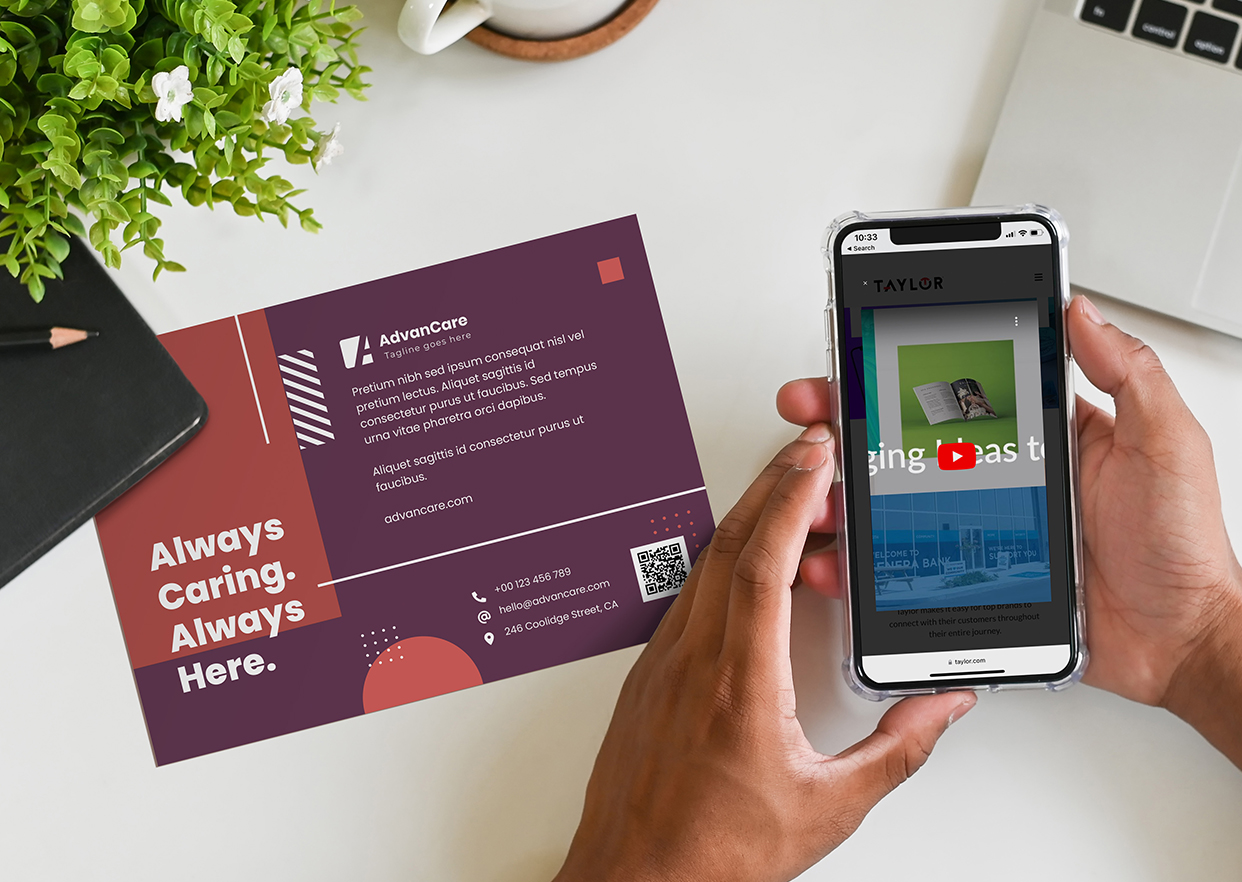According to the most recent U.S. Census Bureau data, nearly 8% of the U.S. population moved in 2024 — roughly 26 million people across 15 million households nationwide.
This movement creates massive opportunities for the furniture stores, moving and storage companies, home décor retailers and local service providers who are open to using targeted direct mail for new movers. Research from Deloitte reflects the extraordinary consumer behavior triggered by moving to a new home, all of which can be directly addressed via strategic direct mail marketing solutions.
- New movers spend an average of $9,000 to $12,000 on furniture, appliances, home services and other needs within the first six months of moving.

- Nearly 60% of new movers undertake home improvement projects within the first year, spending an average of $4,000 to $5,000.

- More than 80% of new movers search for local services such as childcare, fitness clubs, dentists and urgent care centers.

- New movers are five times more likely to become long-term customers of brands they engage with during the moving process.
This blog will explore the concept of targeted direct mail marketing services in general and how new mover direct mail companies use the power of data to reach new movers cost-effectively. We will finish by exploring the best practices for creating a successful new mover direct mail campaign as well as some tips for direct mail for movers specifically.
What are the different types of direct mail?
Direct mail marketing encompasses a wide variety of tactics with one key common denominator — the marketing materials are sent directly to a recipient’s mailbox. Each direct mail advertising format serves a unique purpose and can be tailored to different campaign goals, budgets and audiences. Direct mail programs commonly revolve around the following mail piece formats.
Direct mail postcards
Postcards are one of the most cost-effective and versatile forms of direct mail marketing. They’re ideal for short, impactful messages — like announcing a sale, promoting a grand opening or offering a discount. Their open format ensures the message is seen immediately, without needing to be opened.
Letters and Envelopes
Traditional direct mail letters offer a more personal and formal approach. They’re often used for detailed messages such as service introductions or financial offers. Including a personalized letter in an envelope can create a sense of importance and exclusivity.
Self-Mailers
A self-mailer is a folded piece of mail (like a brochure or flyer) that doesn’t require an envelope. It’s a great way to include more information than a postcard while keeping direct mail program costs lower than a letter package.
Catalogs and Booklets
Catalogs are ideal for showcasing a wide range of products or services. Direct mail campaigns based on catalogs are commonly used by retailers and service providers who want to give recipients a comprehensive look at their offerings.
Dimensional Mailers
Dimensional mailers are direct mail packages or boxes that stand out in the mailbox. They’re more expensive to produce and send but can yield high engagement rates due to their novelty and perceived value. They are often used for B2B or high-value consumer campaigns.
Coupons
Coupons are direct marketing solutions that are intended to drive immediate action. Whether included in a postcard, letter or flyer, they’re especially effective for restaurants, retail stores and the types of local services mentioned previously.
What is targeted direct mail?
Targeted direct mail marketing is the practice of sending personalized, relevant mail to a specific audience based on data such as demographics, location, behavior or life events. Unlike mass mailings, targeted direct marketing solutions are designed to reach the right person with the right message at the right time.
Targeted direct mail marketing relies on data-driven insights to gain this advantage. Marketers can segment their audience using criteria such as:
- Geographic location (e.g., ZIP code, neighborhood)
- Demographics (e.g., age, income, household size)
- Purchase behavior (e.g., past purchases, purchase intent, loyalty status)
- Life events (e.g., newlyweds, new parents)
- Interests and preferences (e.g., pet owners, fitness enthusiasts)
In the case of targeted direct mail for new movers, the life event is the move itself. Next, we will explain how this piece of life event data allows for precise audience segmentation and highly personalized messaging — which increases the likelihood of engagement and conversion.
Why is direct mail effective for new movers?
It’s no secret that digital marketing now accounts for the largest share of the average marketing budget. However, direct mail marketing continues to prove its value as a powerful, tactile and highly targeted marketing channel — especially among new movers. Here’s why.
The New Mover Mindset
When people move, they’re in a state of transition. They’re actively seeking new providers for everything from furniture and healthcare to financial services and entertainment. This creates a rare window of opportunity where brand loyalties are reset and consumers are more open to trying new products and services.
The Power of New Mover Direct Mail
New movers are a highly valuable audience for marketers, representing a flurry of purchasing decisions, lifestyle changes and brand-switching opportunities. Direct mail campaigns, in turn, are among the most effective ways to reach and influence this lucrative audience for four reasons.
1) Relevance
Proprietary data sources allow new mover direct mail companies to target an audience with precision. No direct marketing dollars are wasted on people who have lived in their homes for many years and are, therefore, not “in market” for certain services.
2) Presence
Based on the “move to” address of the recipient, direct mail can introduce movers to businesses and services located nearby. No money is wasted on marketing to people who live outside the immediate geographic area.
3) Credibility
Printed materials often feel more trustworthy than digital ads, especially when they include personalized offers or neighborhood-specific messaging.
4) Timeliness
As the Deloitte research indicates, new movers make a lot of purchasing decisions as a result of the life event. A well-timed coupon or welcome package can drive immediate action among time-crunched new movers actively looking for deals on furniture, appliances, home services and more.
The best practices for creating a successful new mover direct mail campaign
We’ve established that new movers are actively seeking local services, home essentials and community connections — making them ideal targets for direct mail marketing plans. However, to truly stand out in the mailbox and win their loyalty, your direct mail programs need to be strategic, timely and personal.
Here are the best practices for creating a successful direct mail campaign that resonates with new movers and drives results.
1. Start With Accurate Data
The foundation of any successful direct mail campaign is high-quality data. For new mover direct mail campaigns, this means sourcing data that is:
- Timely: Aim to connect within the first 30–60 days. Better yet, use pre-mover data that ensures you are “first in the mailbox” and can make contact with the consumer before the purchase decision is made. The sooner you reach the mover, the better.
- Verified: Use reputable data providers that update their lists frequently and verify addresses through USPS or other reliable sources.
- Targeted: Filter your list by geography, home value, household size or other relevant demographics to ensure your message reaches the right audience.
2. Craft a Warm, Welcoming Message
Moving is stressful and new movers are often overwhelmed with decisions. Your marketing direct mail pieces should feel like a friendly introduction, not a hard sell. Focus on:
- Tone: Use warm, conversational language. Phrases like “Welcome to the neighborhood!” or “We’re glad you’re here” go a long way.
- Relevance: Highlight how your product or service can make their transition easier or more enjoyable.
- Connection: Emphasize your local presence and how you support the community.
3. Offer Real Value
New movers are budget-conscious and looking for deals. A compelling offer can be the difference between direct mail advertising that is tossed or acted upon. Consider:
- Exclusive Discounts: “New mover special: 20% off your first service.”
- Freebies: “Free consultation,” “Free pizza with your first order,” or “Free welcome gift.”
- Bundled Services: Combine multiple offerings into a convenient package (e.g., home cleaning + carpet shampooing). Make sure your offer has a clear expiration date to create urgency and drive immediate action.
4. Design for Impact and Clarity
Your mailer should be visually appealing and easy to digest at a glance:
- Bold Headlines: Grab attention with a clear, benefit-driven headline.
- Simple Layout: Avoid clutter. Use white space, bullet points and clear calls to action.
- Branding: Include your logo, colors and contact information prominently.
Bonus Tip: Postcards are especially effective for new mover campaigns because they don’t require opening and deliver your message instantly.
5. Personalize Whenever Possible
Personalization increases response rates. Even simple touches like using the recipient’s name or referencing their new address can make direct mail marketing feel more relevant. Advanced personalization might include:
- Customized offers based on home value or household size.
- Localized content, such as a map of nearby store locations or community events.
- QR codes that lead to personalized landing pages or appointment booking tools.
6. Time It Right
Timing is everything in a new mover campaign. Ideally, you want to reach recipients:
- Before the move, when they are facing countless decisions.
- Within the first 30 days of the move, when they’re actively setting up their new life.
- With follow-ups at 60 and 90 days to stay top-of-mind and capture delayed decisions.
Bonus Tip: Create a multi-touch campaign that nurtures the relationship over time rather than relying on a single contact.
7. Track and Measure Results
To understand what’s working and improve future campaigns, you need to track performance. Consider using:
- Promo codes or unique URLs to track redemptions.
- Call tracking numbers to monitor phone inquiries.
- QR codes linked to landing pages with analytics.
8. Integrate With Digital Channels
Direct mail is even more powerful when combined with digital marketing. An omnichannel approach increases brand recall and improves conversion rates. For example:
- Retargeting: Use digital ads to follow up with recipients who visited your website.
- Email follow-ups: If you collect email addresses, send a welcome series that complements your direct mail campaign.
- Social media: Reinforce your message with geo-targeted ads on Facebook, Instagram or Nextdoor.
What about direct mail offerings for moving services?
All of the above best practices apply to any direct mail marketing strategy for moving companies. However, the element of timing is especially critical in the moving and storage industry. Unlike a furniture retailer or dental office, a moving company must make contact with the new mover long before the move date in order to be successful.
For direct mail marketing for moving companies, verified pre-mover data is absolutely essential. Data sources exist that enable new mover direct mail companies to identify — and reach — prospective new movers well in advance of the move. The benefits of direct mail for movers are amplified by being first in the mailbox, enabling a moving company to create a relationship and secure a signed contract with the customer long before competitors are even aware of the opportunity.
Taylor: Targeted direct mail marketing for new movers?
Taylor is one of the most sophisticated direct mail marketing providers in North America. All of the direct mail marketing services described above are available in one partner. Taylor combines state-of-the-art printing technology (including lenticular print effects) and industry-leading data management techniques to deliver all types of direct mail campaigns including:
- Postcards
- Letters
- Self-mailers
- Coupons
- Direct mail packages
- Omnichannel direct marketing solutions via mail, email, SMS text and digital targeting
In addition, our Mover 2.0 data source offers the type of verified pre-mover data insights needed by moving and storage companies. Direct mail flyers for moving companies and moving company direct mail postcards have a built-in advantage when they arrive in the mailbox long before the move has occurred. Thanks to Mover 2.0, Taylor is able to:
- Reach potential prospects an average of 14 days sooner than traditional new mover sources.
- Provide access to verified pre-movers with “move from” and “move to” addresses to promote products and services 2-6 weeks in advance of a move.
See for yourself the importance of a direct mail marketing campaign for new movers — especially when that campaign is powered by Mover 2.0 data. Contact Taylor for fresh direct mail marketing ideas, including our precisely targeted new mover direct mail campaigns.








